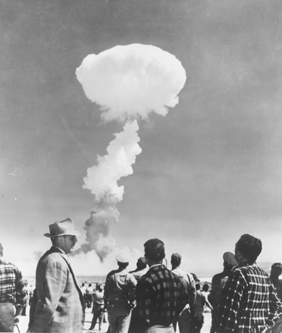They shook the world for a living — now they want to make sure they leave a mark.
“They” is a group of veterans of the Nevada Test Site (NTS) and their associates across the nation’s nuclear weapons complex whose work supported the above-ground and underground tests at the site for more than 40 years.
This select fraternity wants to make sure its singular contribution to the nation’s history is remembered. To that end, they’ve established the Nevada Test Site Historical Foundation and are planning to build a museum and archives in Las Vegas to showcase and preserve their efforts.

Paul Raglin, Manager of Sandia Nevada Programs and the Sandia lead for generating interest in the Foundation and museum, recounts how the formal preservation effort got started. A couple of years ago a few NTS veterans “were kicking around the fact” that, as the Cold War receded into the past “we stood to lose a huge amount of history.” The collective national memory of the efforts of the NTS weaponeers — the scientists, the engineers, the technicians, the support teams — “would just kind of evaporate,” Paul says.
Paul credits long-time DOE officials Troy Wade and Bruce Church with providing the spark to get the Foundation up and running. They were concerned that the history of NTS could be “irrecoverably lost” if no action was taken, and soon. The two launched the Nevada Atomic Testing History Institute (NATHI), of which the Historical Foundation is one component. (Other entities comprising NAHTI include the University of Nevada-Las Vegas’s Desert Research Institute [DRI] and DOE’s Nevada Operations Office [DOE/NV].)
The Foundation’s first foray into historical preservation consisted of a quarterly newsletter, which featured recollections by NTS vets, news about reunions, solicitations for historical artifacts and memoirs, and announcements about Foundation business.
“That was a nice start,” Paul says, but the Foundation’s officers quickly came to realize that, to really fulfill its self-defined mission — “to preserve and foster public [emphasis added] accessibility to the history associated with the NTS” — it needed to establish a museum and an archives.
Partnering with DRI and DOE/NV and with bonding approval from the GSA, the Foundation got the go-ahead to construct a 59,000-square-foot, $10 million building at DRI’s campus near the Strip in Las Vegas. The building will house the Foundation museum collection as well as DRI’s archeological collection and DOE/NV’s records collection. The building/museum will be located in Las Vegas rather than at the test site some 65 miles northwest of the city at Nellis AFB, to accommodate the visiting public and to maximize its educational value. Recognition of this effort was also made nationally when the museum was chartered as an Associate Member of the Smithsonian Institution.
Groundbreaking for the new building is set for Dec. 18, timed to coincide with the 50th anniversary of the establishment of what was then called the Nevada Proving Grounds by President Harry Truman.
Paul says the Foundation is always seeking new members, but just as important, is also trying to track down any test-related artifacts, drawings, models, miniatures — “anything that might be stuck in a warehouse somewhere” — that might augment the museum’s collection. Anything, in fact, that “could be rolled into a display.” (If you have knowledge of anything that might be of interest to the museum, call Paul at 845-7049 and leave a message.)
Jim Wadell, Assistant Director of the National Atomic Museum In Albuquerque, welcomes the idea of a sister facility in Las Vegas.
“Testing is a vital part of the history of the nation’s development of the nuclear stockpile,” Jim says, “and NTS is a huge part of that history. The NTS Foundation’s museum will focus on a specific piece of our nuclear history with a much greater level of detail than we could here [at the National Atomic Museum]. I think what they’re doing will complement our efforts.
“Some folks may look at their plans and say ‘Gee, you all have a competitor.’ But that’s not true. Not at all. No more so than the Bradbury Museum [at Los Alamos National Laboratory] is a competitor. The fact is that we all support each other and we all increase the level of knowledge and interest in a unique part of American history. What the Foundation’s doing is good for everybody.”
Paul notes that NTS veterans aren’t limited to those who actually did work at the test site. Over the years, he says, thousands of Sandians worked in programs and projects that supported the tests. The Foundation encourages those individuals to join and get involved in the preservation effort as well.
“This is a real opportunity to support what Sandia has contributed to the development of nuclear weapons at the Nevada Test Site,” Paul says.
Last modified: July 18, 2000